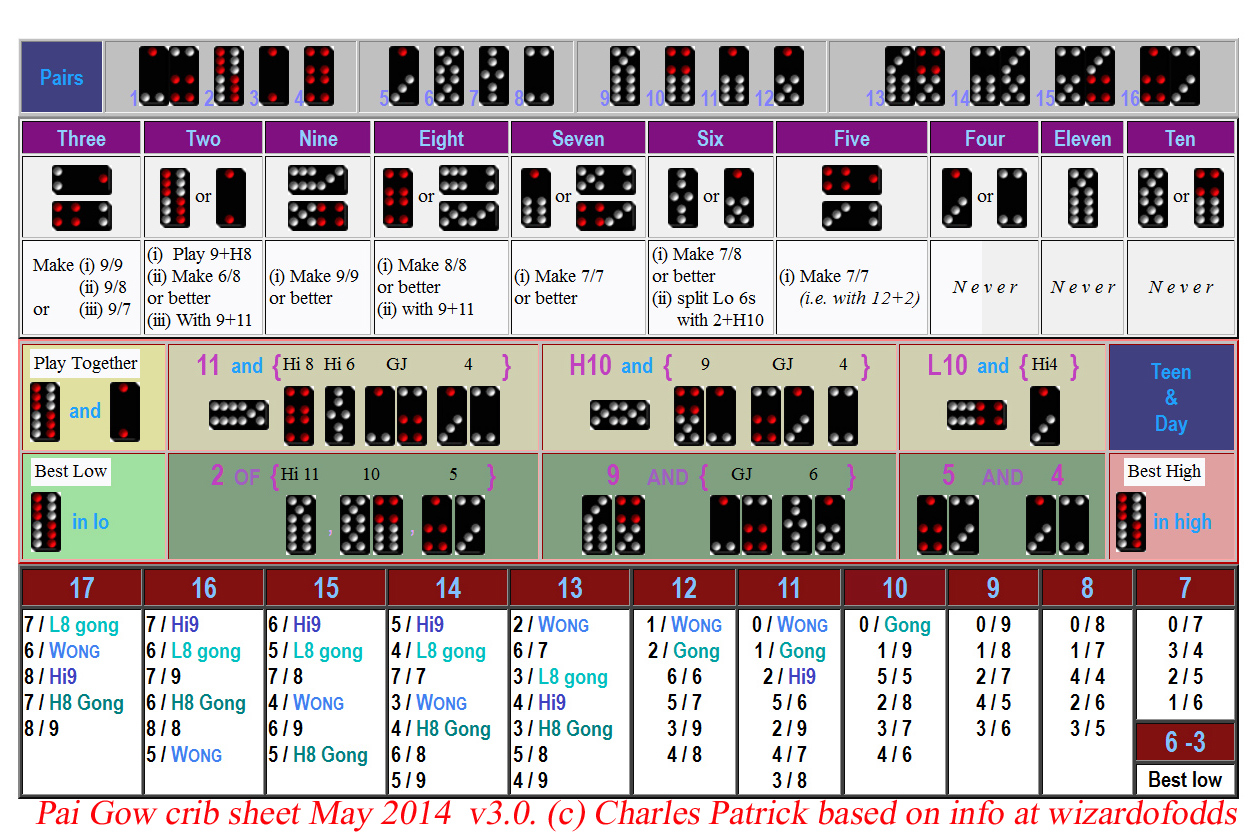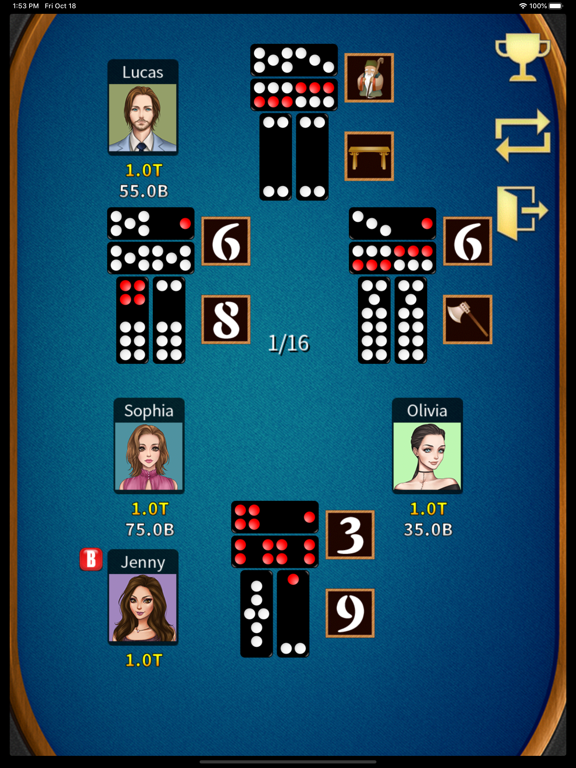Pai Gow Poker Strategy Calculator
| Origin | United States |
|---|---|
| Players | 2–7 |
| Deck | French |
| Play | Clockwise |
| Card rank (highest first) | A K Q J 10 9 8 7 6 5 4 3 2 |
| Random chance | High |
| Related games | |
| Chinese poker | |
Pai gow poker (also called double-hand poker) is a version of pai gow that is played with playing cards, instead of traditional pai gow's Chinese dominoes. The game of pai gow poker was created in 1985 in the United States by Sam Torosian, owner of the Bell Card Club.[1]
Pai Gow Poker Strategy. Well, there isn’t a set strategy that guarantees you a win. This is because when playing, the gambler can’t see the cards for them to pick the best. Unlike the standard version of pai gow, using a bluff or any other usual poker tricks do not really help Pai Gow poker. This calculator will analyze any Pai Gow Poker hand. Select seven cards and the results will appear below the entry form. Note that the results do not show invalid plays or duplicates of a valid play that is already listed. While the strategy should be effective against any house way, the exact figures are specific to the Foxwoods rules.
The game is played with a standard 52-card deck, plus a single joker. It is played on a table set for six players, plus the dealer. Each player attempts to defeat the banker (who may be the casino dealer, one of the other players at the table, or a player acting in tandem with the dealer as co-bankers).[2]
Winning condition[edit]
The object of pai gow poker is to create a five card poker hand and a two card poker hand from seven cards that beat both of the bank's hands. The five-card hand's rank must exceed that of the two-card hand, and it is for this reason that the two-card hand is often called the hand 'in front', 'on top', 'hair', or the 'small', 'minor', or 'low' hand. The five-card hand is called the hand 'behind', or the 'bottom', 'high', or 'big', as they are placed that way in front of the player, when the player is done setting them.
Deals[edit]
The cards are shuffled, and then dealt to the table in seven face-down piles of seven cards per pile. Four cards are unused regardless of the number of people playing.
Betting positions are assigned a number from 1 to 7, starting with whichever player is acting as banker that hand, and counting counter-clockwise around the table. A number from 1 to 7 is randomly chosen (either electronically or manually with dice), then the deal begins with the corresponding position and proceeds counter-clockwise. One common way of using dice to determine the dealer starting number is to roll three six-sided dice, and then count betting spots clockwise from the first position until the number on the dice is reached.
If a player is not sitting on a particular spot, the hand is still assigned, but then placed on the discard pile with the four unused cards. In some casinos, such as the Golden Nugget and Palms in Las Vegas, Nevada, an extra 'dragon hand' is dealt if a seat is vacant. After all players have set their original hand they are asked in turn if they would like to place another bet to play the dragon hand. Generally the bet on the dragon hand can be the table minimum up to the amount the player bet on their original hand. The first player to accept the dragon hand receives it; this player is effectively playing two separate hands. Rules vary from casino to casino, but generally the dealer turns over the dragon hand and sets it using the house way. This is because the player has already seen the seven cards of their original hand, which could affect the way they would set the dragon hand.
Hand rankings[edit]

The only two-card hands are one pair and high cards.
Five-card hands use standard poker hand rankings with one exception: in most casinos, the 'wheel' (the hand A-2-3-4-5) is the second-highest straight. At most casinos in California and Michigan this rule doesn't apply, and A-2-3-4-5 is the lowest possible straight.
The joker plays as a bug, that is, in the five-card hand it can be used to complete a straight or flush if possible; otherwise it is an ace. In the two-card hand it always plays as an ace, except in several southern Californian casinos where the joker is wild.
Win reckoning[edit]
If each of the player's hands beats each of the banker's corresponding hands, then he wins the bet. If only one of his hands beats the banker then he pushes (ties) in which case neither he nor the banker wins the bet. If both of his hands lose to the banker then he loses.
On each hand, ties go to the banker (for example, if a player's five-card hand loses to the banker and his two-card hand ties the banker then the player loses); this gives the banker a small advantage. If the player fouls his hand, meaning that his two-card hand outranks his five-card hand, or that there are an incorrect number of cards in each hand, there will usually be a penalty: either re-arrangement of the hand according to house rules or forfeiture of the hand.
In casino-banked games, the banker is generally required to set his hand in a pre-specified manner, called the 'house way', so that the dealer does not have to implement any strategy in order to beat the players. When a player is banking, he is free to set the hand however he chooses; however, players have the option of 'co-banking' with the house, and if this option is chosen then the player's hand must also be set in the house way.
California casinos typically charge a flat fee per hand (such as 5 cents or one dollar) to play, win or lose. Other casinos take a 5% commission out of the winnings, which is usually known as the rake.[3]
Variants[edit]
There are a number of variations of Pai Gow poker that are popular in casinos today. These variations were mainly formulated in 2004 through 2009. Pai Gow Mania was the first variation to be created which allows for two side bets instead of the traditional one side bet per hand. Fortune Pai Gow is another variation which allows players to make a side bet on a poker hand ranking of three-of-a-kind or better, one of the most popular variations. Similar is Emperors Challenge, which also allows a side bet on a seven-card pai gow (no hand). Shuffle Master introduced a variation of the game in 2006, adding a progressive jackpot side bet, named Progressive Fortune Pai Gow. Part or all of the jackpot may be won by placing a side bet and landing one of the hands specified on the payout table; a combined seven-card straight flush wins the entire jackpot.[4]
Advantage play[edit]
Advantage play refers to legal methods used to gain an advantage while gambling. In pai gow poker, a player may be able to gain an advantage in certain circumstances by banking as often as possible, taking advantage of unskilled players while banking, and dealer errors when not banking.[3]
History[edit]
Sam Torosian, owner of the Bell Card Club in Los Angeles, invented the game of Pai Gow Poker in 1985. The idea for the game came to Torosian after being told about the game Pusoy by an elderly Filipino customer. He figured that the 13-card game with players arranging three hands would be too slow, but a simplified two-hand version with only seven cards would be faster and easier for players to learn. The game quickly became popular and by the late 1980s was being played on the Las Vegas Strip, and eventually worldwide. Torosian famously failed to patent the game he invented after being given bad advice by an attorney he consulted, and noted poker author Mike Caro, both of whom told him that the game was not patentable.[1]

See also[edit]
References[edit]
- ^ abRichard Marosi (3 November 2002). 'Casino Boss Can't Cash In on Game He Developed'. Los Angeles Times. Retrieved 21 December 2016.
- ^Michael Shackleford. 'Pai Gow Poker'. The Wizard of Odds. Retrieved 21 December 2016.
- ^ abWong, Stanford (1993). Optimal strategy for Pai Gow Poker. La Jolla, CA.: Pie Yee Press. ISBN978-0935926170.
- ^'Pai Gow Poker Variants'. Play Pai Gow Now. Retrieved 21 December 2016.

External links[edit]
Administrator


1. Enter player strategy.
2. Enter opponent strategy.
3. Enter tiles known of other players.
4. Enter tiles known of the opponent.
5. Enter just 1 to 3 player tiles.
6. Enter commission.
I think the most practical benefit is to see how to adjust your strategy based on the tiles of other players. I get asked about this often.
So you guys get to be my guinea pigs again. Please give it a test run and let me know what you think before I release it to the whole world.
I realize this might entail a complete overhaul of the main PG game, so it may be asking a lot, but that is what I would like to see most.
Pai Gow Poker Strategy Calculator For Real
Help, mighty Wizard!
Pai Gow Poker Strategy Chart
Parlay Odds, Calculate Parlays